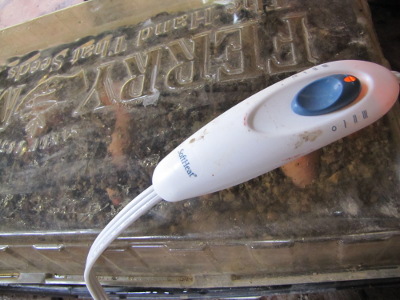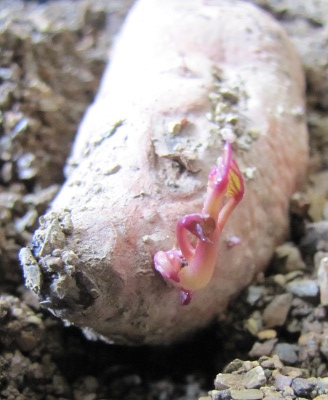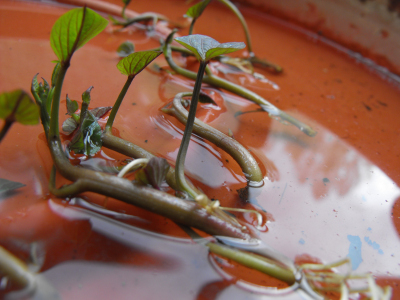
How to start sweet potato slips
 "Fascinating
- I have never seen this before! I thought you just plant [sweet
potatoes] like regular potatoes. Can you post pictures as they
sprout and
what you do with them later? Thank you!" --- Alice R.
"Fascinating
- I have never seen this before! I thought you just plant [sweet
potatoes] like regular potatoes. Can you post pictures as they
sprout and
what you do with them later? Thank you!" --- Alice R.
I thought I'd already made a
cohesive post about propagating sweet potatoes, then realized I was
thinking of the chapter I included on sweet potatoes in the second
edition of Homegrown Humus.
For those of you who haven't given that ebook a read, here's my
tried-and-true method of making homegrown slips --- the little rooted
plants that you use to grow sweet potatoes in the garden.
 As
Mark posted earlier this week, we start by sinking a few skinny tubers
halfway into wet gravel in the bottom of a seed-starting tray (with the
insert removed). I generally save out skinny tubers on
purpose, selecting ones that are less than two inches in diameter since
they seem to spit out slips quickly without wasting too much food.
As
Mark posted earlier this week, we start by sinking a few skinny tubers
halfway into wet gravel in the bottom of a seed-starting tray (with the
insert removed). I generally save out skinny tubers on
purpose, selecting ones that are less than two inches in diameter since
they seem to spit out slips quickly without wasting too much food.
I place a heating pad
turned to medium or high (depending on the weather) under the flat, and
then mostly ignore it for a few weeks. You can choose to put the
clear top on the seed-starting tray, in which case you really can ignore
the contents (although mold might start to form). Alternatively,
you can leave the top off and just add water as needed to keep the
gravel moist. The warm, moist environment will soon tempt your
tubers to grow little sprouts like the one pictured above.
Once
these sprouts start popping up, it's time to take off the top of the
tray (and to make sure you keep the tray well watered). The
sprouts will grow quickly, and several will pop up on each end of most
tubers. Once a sprout is about four inches long, simply snap it
off the tuber and place it in a vase or other container of water so the
bottom half inch of the sprout is  under water. Within a week, each
sprout should have at least two or three roots an inch or so long ---
you've grown your own sweet potato slips!
under water. Within a week, each
sprout should have at least two or three roots an inch or so long ---
you've grown your own sweet potato slips!
Sweet potatoes like it
warm, so wait until after the frost-free date to plant them out in your
garden. Pick an overcast day (or set them out in the evening) and plant
each slip so the leaves are above ground and the roots are below
ground. Water them in well, and come back by the next day to water
again as needed. After that, they'll take off and will provide a
carefree crop (as long as you keep the deer away). Happy sweet potatoing!
Want more in-depth information? Browse through our books.
Or explore more posts by date or by subject.
About us: Anna Hess and Mark Hamilton spent over a decade living self-sufficiently in the mountains of Virginia before moving north to start over from scratch in the foothills of Ohio. They've experimented with permaculture, no-till gardening, trailersteading, home-based microbusinesses and much more, writing about their adventures in both blogs and books.
Want to be notified when new comments are posted on this page? Click on the RSS button after you add a comment to subscribe to the comment feed, or simply check the box beside "email replies to me" while writing your comment.

Anna, Glenn Drowns at Sand Hill Preservation Center has a ton of sweet potato info on his website. He has raised organic sweet potatos for years and amassed lots of info. It would worth your time to check it out. I enjoy your posts.
Do you not worry about actually selecting the least productive, vigorous, high yielding, disease resistant roots/plants, when you choose the smallest roots to propagate? I'm just curious to your thoughts on this.
While you are "cloning" the sweet potatoes, mutations still occur, regional adaptations etc, and viruses that affect out put, size of the roots, and vigor still accumulate. So while you may lose a few of your best looking roots wouldn't it be better to choose those ones out to regrow, and eat the smaller, possibly less healthy for growing stock, sweet potatoes?
Great comments, everybody!
Michelle --- We started with Beauregard slips from our local feed store our first year. Then, the next year, we made our own slips from those tubers. They were so productive and tasty, we didn't feel the need to explore further.
T --- Excellent, thought-provoking point. It is true that, as Carol Deppe would say, if you're not actively breeding, you're probably letting the variety get worse over time. The small sweet potato roots don't tend to be from plants that are all small potatoes, though; instead, they tend to be the tubers that start late in the year off clumps that already have lots of big potatoes in them. But it probably would be better to collect them when I dig the hills, taking the small potatoes from clumps that have lots of big potatoes in them. I'll have to start doing that!
OMGosh, I haven’t done that since I was a kid! Mostly we didn’t plant them…just had fun watching them grow. I have some sweet potatoes in the pantry, and I think I’ll start them to plant outside. Thanks for the tutorial. Visiting from My Turn for Us, Freedom Fridays.